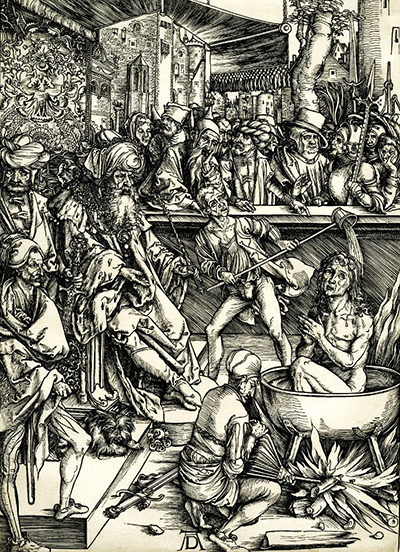Of all the most critical works in Durer's history of printmaking is the Apocalypse. It is a series of 15 woodcuts and a title, the Martyrdom of St. John, published in 1498. The series forms the first Durer's mature style as the father of the northern Renaissance.
This print was in the history of woodcuts, which has had a vast impact on the arty of the Apocalypse in all media. Durer's work is based on a trip he conducted to Italy to study the Renaissance's novel, after which, he created the 15 Apocalypse images two years after returning to Nuremberg. He drew the late gothic northern traditions infused with the reality of spiritual events and biblical analysis. In this masterful woodcut, Durer conveys the torture and Martyrdom of Saint John the Evangelist, equated with the historical figure of the Apostle John by Christian Traditions. Although the subject of this print from the Apocalypse is not present in the book of Revelation, Durer added the subject and revealed Saint John as the author, a claim that remains an argument to many people.
The subject of St. John's martyrdom was a common thing in medieval art, and regardless of Durer's highly advanced woodcut technique, this print shows an ancient interpretation of the story. After Saint John refused to renounce his Christian faith and worship the pagan gods, Roman Emperor Domitian sentenced him to death. The print shows Saint John sitting naked in a bath set on fire by the executioner's fan, and another one pours boiling oil over the body of Saint John. Domitian is seen seated to the saint's left side and dressed as a Turkish sultan, an enemy of Durer's Holy Roman Empire, to portray his hostile nature to Christianity. Even though the early Christian stories and writings tell Saint John's miraculous survival from the cauldron of oil, the apocalypse versions contradict the story. Instead, it records Saint John's murder.
Durer makes Saint John's visions concrete and believable with the realistic nature of his works. The serene landscapes look real except for the heavenly beings as characters are in modern dress. Besides, the character's bodies are showed in a realistic manner and are quite convincing. The details of lighting, tree, whether, and other objects used are vividly accurate. In the same period, Albrecht also printed several images. They include the Vision of Seven Candlesticks, The Fourth Rider of the Apocalypse, Saint Michael Fighting the Dragon, and much more. Today, the print is located at the National Gallery of Art.




